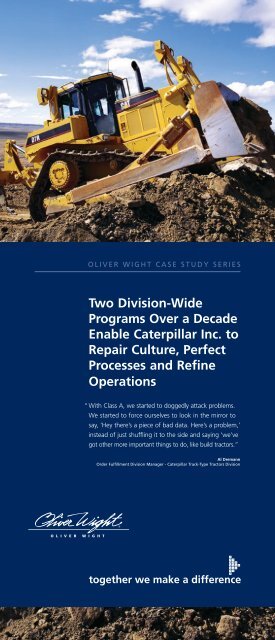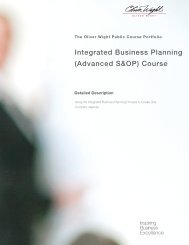Oliver Wight Caterpillar TTTD Case Study - Oliver Wight Americas
Oliver Wight Caterpillar TTTD Case Study - Oliver Wight Americas
Oliver Wight Caterpillar TTTD Case Study - Oliver Wight Americas
- No tags were found...
Create successful ePaper yourself
Turn your PDF publications into a flip-book with our unique Google optimized e-Paper software.
OLIVER WIGHT CASE STUDY SERIESTwo Division-WidePrograms <strong>Oliver</strong> <strong>Wight</strong> Over a DecadeEnable Courses <strong>Caterpillar</strong> & Workshops Inc. toRepair Culture, PerfectJanuary - December 2003Processes and RefineOperations“ With Class A, we started to doggedly attack problems.We started to force ourselves to look in the mirror tosay, ‘Hey there’s a piece of bad data. Here’s a problem,’instead of just shuffling it to the side and saying ‘we’vegot other more important things to do, like build tractors.”Al DremannOrder Fulfillment Division Manager - <strong>Caterpillar</strong> Track-Type Tractors Division®together we make a difference
<strong>Caterpillar</strong> Track-Type Tractors DivisionHighlights:• <strong>Caterpillar</strong>’s Track-Type Tractors Division manufactures a line of heavyequipment including the world’s largest bulldozers. The business unit,based in East Peoria, Illinois, serves all regions of the world, offeringproducts in a variety of configurations.• The division spent years implementing a Common Values program toturn the workplace culture around. Trust, mutual respect, and teamworkbecame watchwords.• The division then looked to improve coordination among its manufacturingmanagers and with a separate marketing division. Sales & OperationsPlanning was implemented to address difficulties with inventory andon-time delivery.• <strong>TTTD</strong> ensured every shop floor person and supervisor understood thebasics of inventory record accuracy and bill of material accuracy, andtook key people through formal classes on topics such as S&OP andValid Schedules.• <strong>Caterpillar</strong>’s <strong>TTTD</strong> improved total supply chain inventory and on-timedelivery, and reduced costs dramatically as it achieved Class A in bothchapters 2 and 5 of The <strong>Oliver</strong> <strong>Wight</strong> ABCD Checklist.With more than $20 Billion in sales and revenues, Fortune 100 company<strong>Caterpillar</strong> Inc. is the world’s largest manufacturer of construction and miningequipment. Located in East Peoria, Illinois, just across the river from corporateheadquarters, and contributing significantly to <strong>Caterpillar</strong>’s revenues, is <strong>Caterpillar</strong>’sTrack-Type Tractors Division (<strong>TTTD</strong>). Because the big earthmovers were the firstin <strong>Caterpillar</strong>’s product line, <strong>TTTD</strong> has been called ‘the soul of <strong>Caterpillar</strong>.’When Jim Despain took over the division as Vice President and General Manager,<strong>TTTD</strong> was hamstrung by conflicts between management and its hourly workforce.One of the longest strikes in history dogged the company through the early 90’s.And newly introduced business-unit accounting showed that <strong>TTTD</strong> was notmaking a profit.‘Common Values’ Cure the CultureA key in the transition to a more engaged work force and accountableprofitability was a major division-wide implementation of a Common Valuesprogram and subsequent revolution in <strong>TTTD</strong>’s culture. Trust, respect and teamworkwere emphasized. Despain told his workers, “Don’t check your brains at thedoor,” and meant it. The results were dramatic. Organized labor was workingwith, not against management. A.J. Rassi, Despain’s successor as GeneralManager, observed that, “people actually began to enjoy coming to work.”
“ Everything that was promised by Class Awas delivered plus more...”This is the point at which our story began. Jim Despain and the CommonValues program had revolutionized <strong>TTTD</strong>’s culture and profit contribution, butthe bottom line had to continue to improve. People were working togetherbetter but often lacked the processes to work efficiently. For example, oneperson in the Fabrications Building went through three cell phone batterieseach day handling emergency calls. In another case, an Operations Supervisorwas spending most of his time as a parts chaser, leaving him little opportunityfor needed supervisory roles. <strong>TTTD</strong> was working together better because ofCommon Values, but harried because of antiquated processes.Class A Builds on the New Culture to Refine the ProcessesIn 1999, the Chairman of <strong>Caterpillar</strong>, Glen Barton, challenged all divisions of<strong>Caterpillar</strong> to achieve Class A certification in Planning and Control. With theirCommon Values firmly in place, <strong>TTTD</strong> aggressively tackled the challenge.One of the <strong>TTTD</strong>’s primary hurdles resulted from the marketing function residing ina different division from manufacturing. This split and associated divergent metricscombined with inaccurate sales forecasts occasionally resulted in inventory surpluses.According to <strong>TTTD</strong>’s Order Fulfillment Division Manager Al Dremann, “At timeswe were at odds [with the marketing division] or didn’t believe the numbers.We didn’t always behave as if we were working for the same company withrespect to a forecast and planning to meet future demand.”The company also looked to improve its on-time delivery performance. Severaldealers carried extra inventory to protect themselves against not receiving partsor equipment on time.When <strong>Oliver</strong> <strong>Wight</strong> consultants were brought in to help the Class Aimplementation, <strong>Caterpillar</strong> managers and supervisors were skeptical abouttheir ability to make improvements. According to Dremann, he and the othermanagers didn’t want to make many changes. “The first time they came herewe thought, ‘We know how to do that, we’ve done that before, so tell ussomething new’. We were defensive and didn’t want to make a lot of changes.”
But, in reality, <strong>TTTD</strong> was not doing all the things it knew how to do, and<strong>Oliver</strong> <strong>Wight</strong> helped them get moving. “The biggest thing that they did wasto serve as a change agent,” Dremann commented. “They acted as independent,objective observers to point out things that needed correction - that neededbest practices implementation - so that we could work at them.”The core of the Class A implementation was the creation and managementof Sales & Operations Planning, a process led by senior management that, ona monthly basis, evaluates revised, time-phased projections for supply, demandand the resulting financials.“One of the best practices mentioned throughout The <strong>Oliver</strong> <strong>Wight</strong> ABCDChecklist for Operational Excellence is the need for a rigorous process,”Dremann said. “Our group now goes through well defined steps and a specificagenda so we are talking about the right things and we are talking about itface to face instead of on the phone and leaving messages. A key to successwas establishing agreements to get people from different divisions workingtogether. It was also very helpful to make sure that everybody understoodwhat the schedule was, that it could be accomplished, and where the potentialproblems were. That way the group could start to attack the things that theycould deal with 2-12 months in the future.”One of the elements of success - and eventual Class A certification - at <strong>Caterpillar</strong>’sTTT Division was the <strong>Oliver</strong> <strong>Wight</strong> classes. They started by putting all secondand third level managers through the Class A Overview. Then, key managersand supervisors attended a hands-on Sales & Operations Planning workshop.Additionally, materials planners, shop floor supervisors, key scheduling people,and process planners learned the basics of Valid Schedules through a formalclass. But the company went farther. Having established a corporate cultureof mutual respect and teamwork, <strong>TTTD</strong> made sure that every shop floorperson attended 2 hours of education on Inventory Record Accuracy and Billof Material Accuracy based on <strong>Oliver</strong> <strong>Wight</strong> material.Dremann credits the S&OP workshop with pointing the group in the rightdirection and starting the process of collaboration with the marketing company.In addition, enrolling such a wide range of people in the <strong>Oliver</strong> <strong>Wight</strong> ValidSchedules class helped the group form more effective teams by getting all oftheir people together for regular, weekly meetings to discuss capacity,scheduling and demand issues.Dremann points to inventory record accuracy as a significant driver of benefitsinside the plant, “Now we have the right materials in the right place at theright time. There is much less non-value added activity looking for material,and it shows up in the cost picture. Plus, people are a lot more content withoutthe stress and pressure of frequent schedule changes caused by missing parts.”The Fabrication Building employee recently said, “It’s 1 PM and I still have threequarters of the charge on my first cell phone battery.” By delivering on timeto Assembly, life became easier. And the parts chaser? Now he has the time tospend on other responsibilities of an Operations Supervisor including safety andquality. Dremann notes that, “Completion, delivery, on-time performance and
manpower planning are all under much better control. For a variety of reasons,including the greater attention that supervisors are able to pay to safetytraining, our plant achieved its best safety record ever in July 2002.”Following one major business improvement program (Common Values) with asecond (Class A) may sound like a ‘flavor-of-the-month’ approach, but that isnot how it worked. Each was given the time and resources required to do itright. And each had vigorous and consistent senior-management support.The Common Values program got the people aligned in support of the company,and the <strong>Oliver</strong> <strong>Wight</strong> Class A implementation gave them the processes theyneeded to excel. Both programs were essential to the resulting success.Synergy Across the Two InitiativesFor the combination of these two programs in <strong>TTTD</strong>, the whole is indeed greaterthan the sum of the parts. “I can’t imagine going through the challengingClass A certification without the great foundation of trust, respect andcooperation that we achieved through the Common Values program,” saidMarv Rosser, <strong>TTTD</strong>’s Operations Manager. “We really benefited from thecontinuity and synergy.”One example of continuity and synergy can be found in the evolving role ofConsensus Teams. They were created as part of the Class A journey to ensurevalid schedules were in place by improving teamwork, trust and commitment- three of the Common Values. As one worker put it, “When our customerstrust us to deliver on time, they don’t call to see where the parts are.”Trust Makes the DifferenceAccording to one originally skeptical <strong>TTTD</strong> employee, “Everything that waspromised by Class A was delivered plus more. Just not being past due anymoreand having a good schedule to run to - having something that’s believablebuilds trust between workers and the people who are setting the schedules.”Working with <strong>Oliver</strong> <strong>Wight</strong>, the <strong>Caterpillar</strong> Track-Type Tractors Divisionachieved Class A Business Excellence with some impressive results.• On-time delivery increased to more than 98%.• Total chain inventory dropped in two years by $45 million.• Unplanned overtime dropped significantly.• Premium airfreight costs were cut.• Redeployed staff as a result of a reduction in non-value-added expediting.<strong>Caterpillar</strong>’s <strong>TTTD</strong> continues to strengthen their Common Values today. Thedivision has been certified Class A in both Chapter 2 (People/Team Processes)and Chapter 5 (Planning and Control Processes) and is now working onrecertification against the updated criteria in the Fifth Edition of the ABCD Checklist.<strong>Case</strong> study kindly authorized for publication by <strong>Caterpillar</strong>, Inc.
®<strong>Oliver</strong> <strong>Wight</strong> <strong>Americas</strong>, Inc12 Newport Road, New LondonNew Hampshire, 03257, USATelephone: 1 800-258-38621 603-526-5800Facsimile: 1 603-526-5809info@oliverwight.comwww.oliverwight.com<strong>Americas</strong>12 Newport Road, New LondonNew Hampshire 03257, USAEurope, Africa & Middle EastThe Willows, The Steadings Business CentreMaisemore, Gloucester GL2 8EY, UKAsia/PacificSuite 2, 15 - 17 Forest Road, HurstvilleN.S.W. 2220, Australia
















